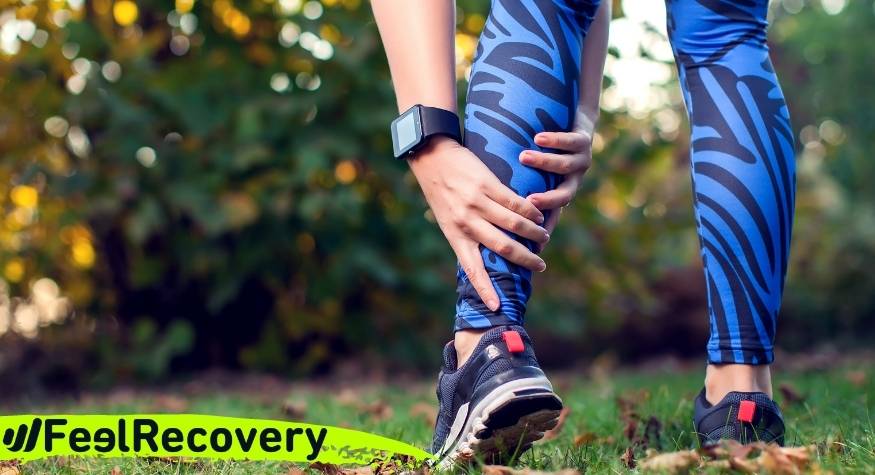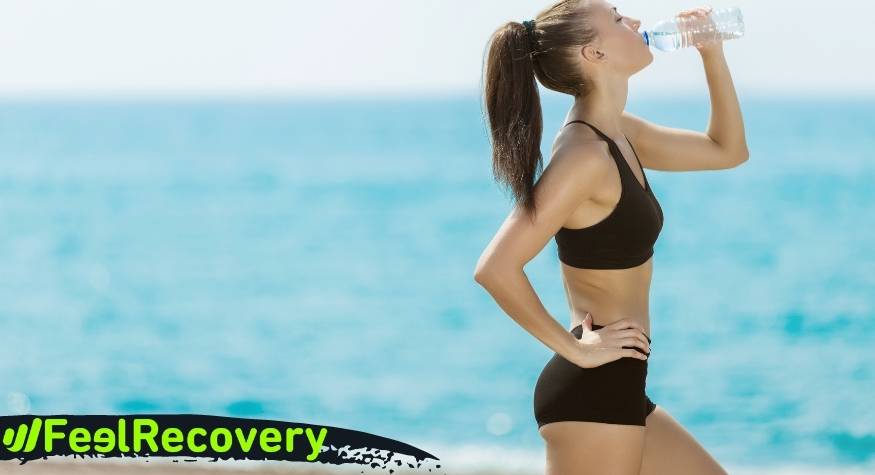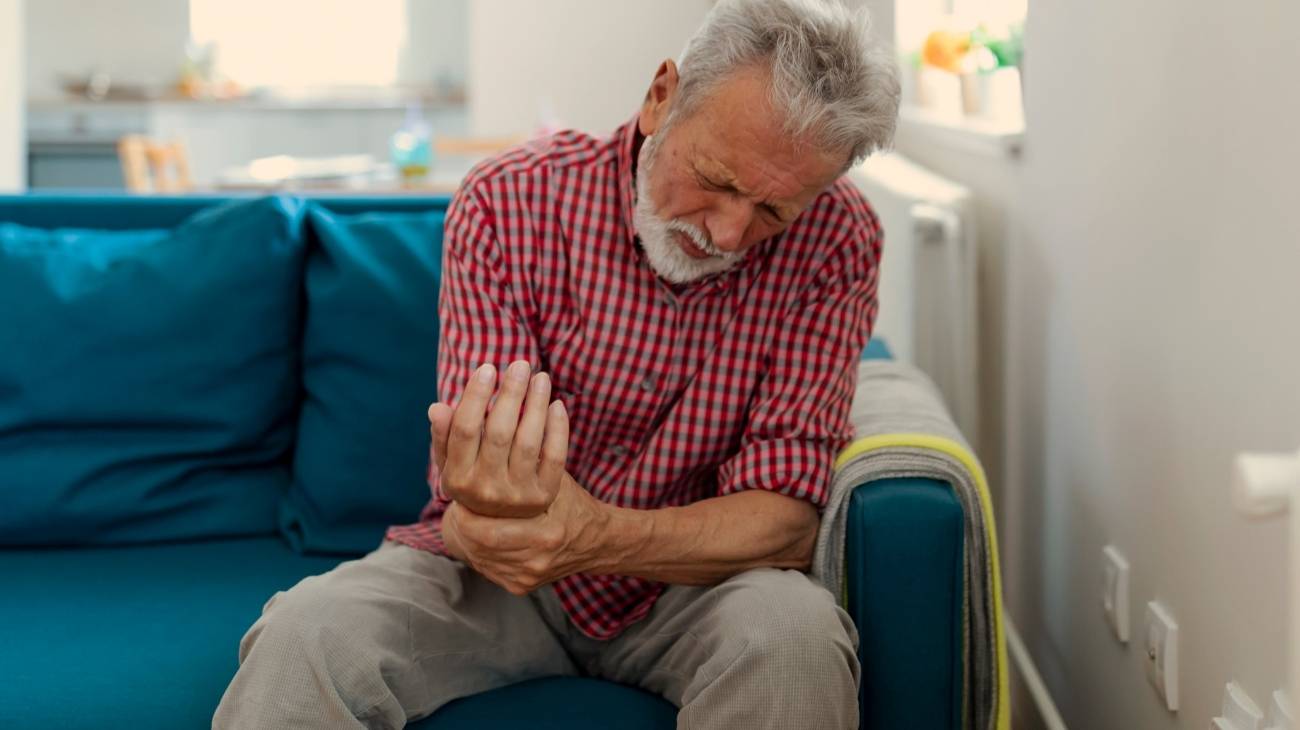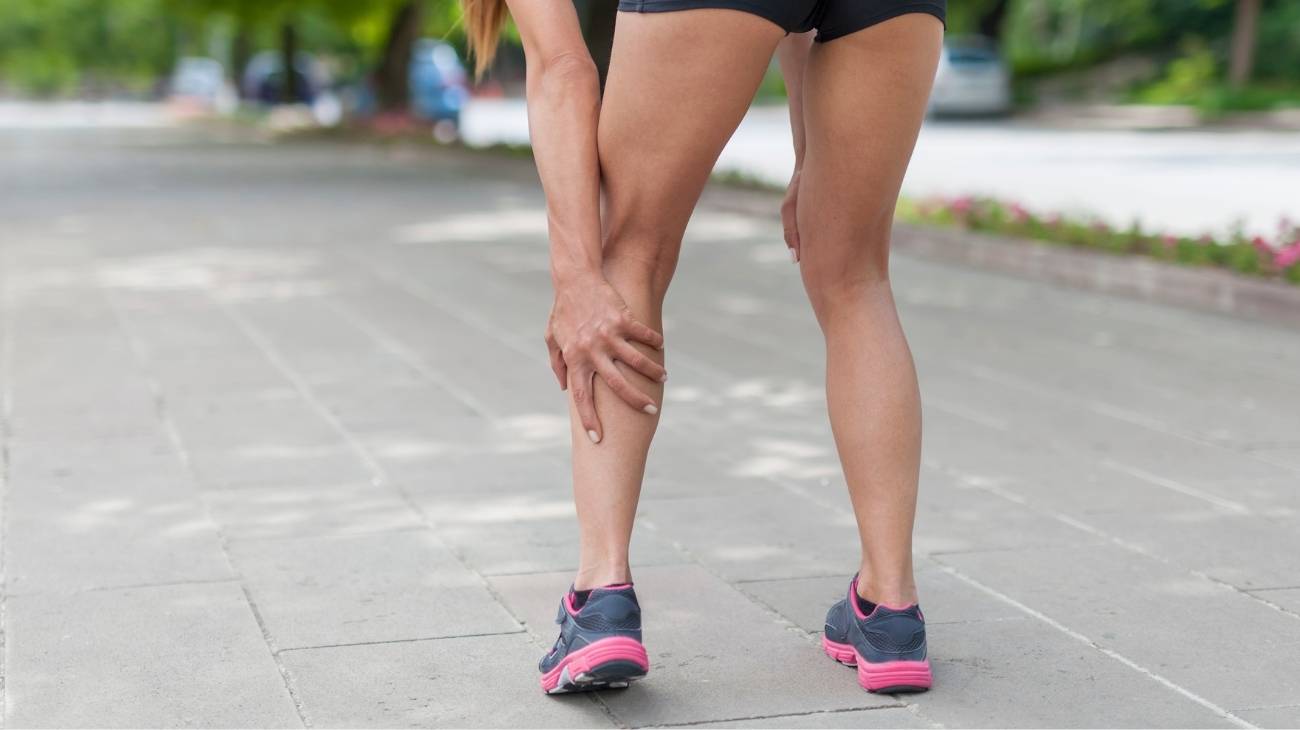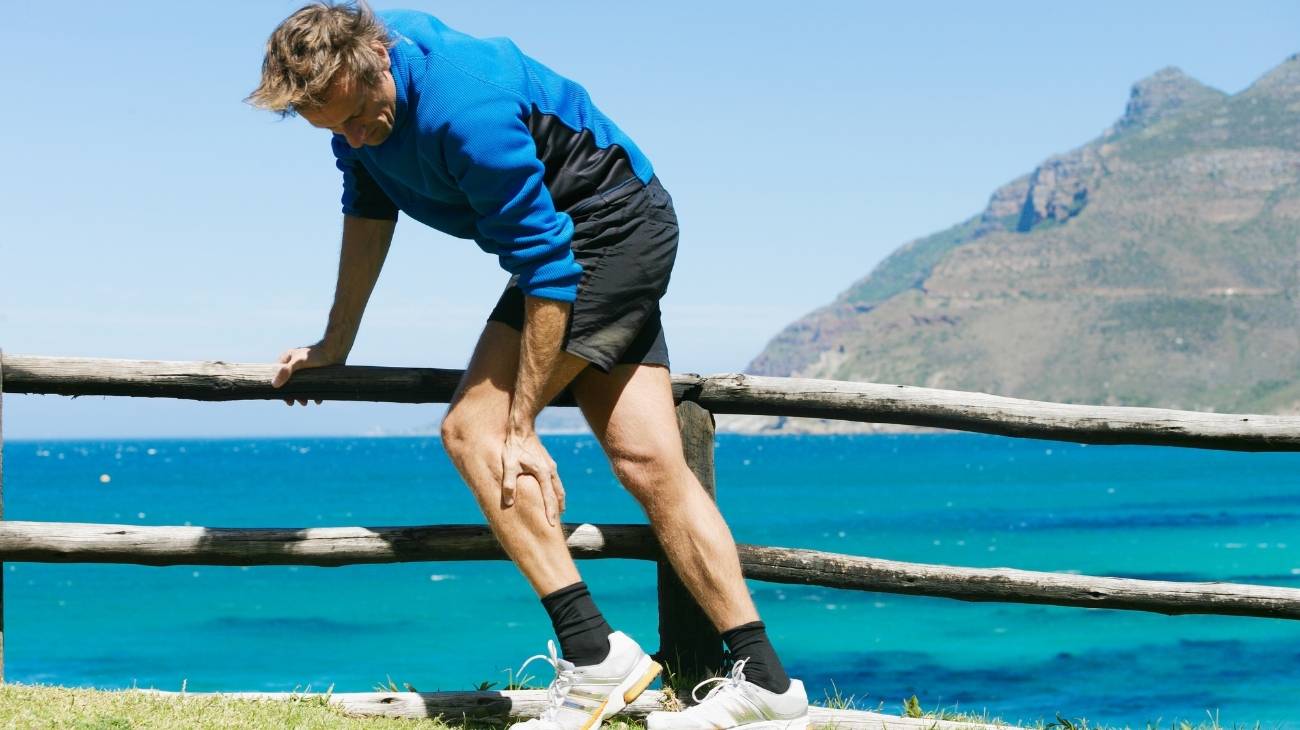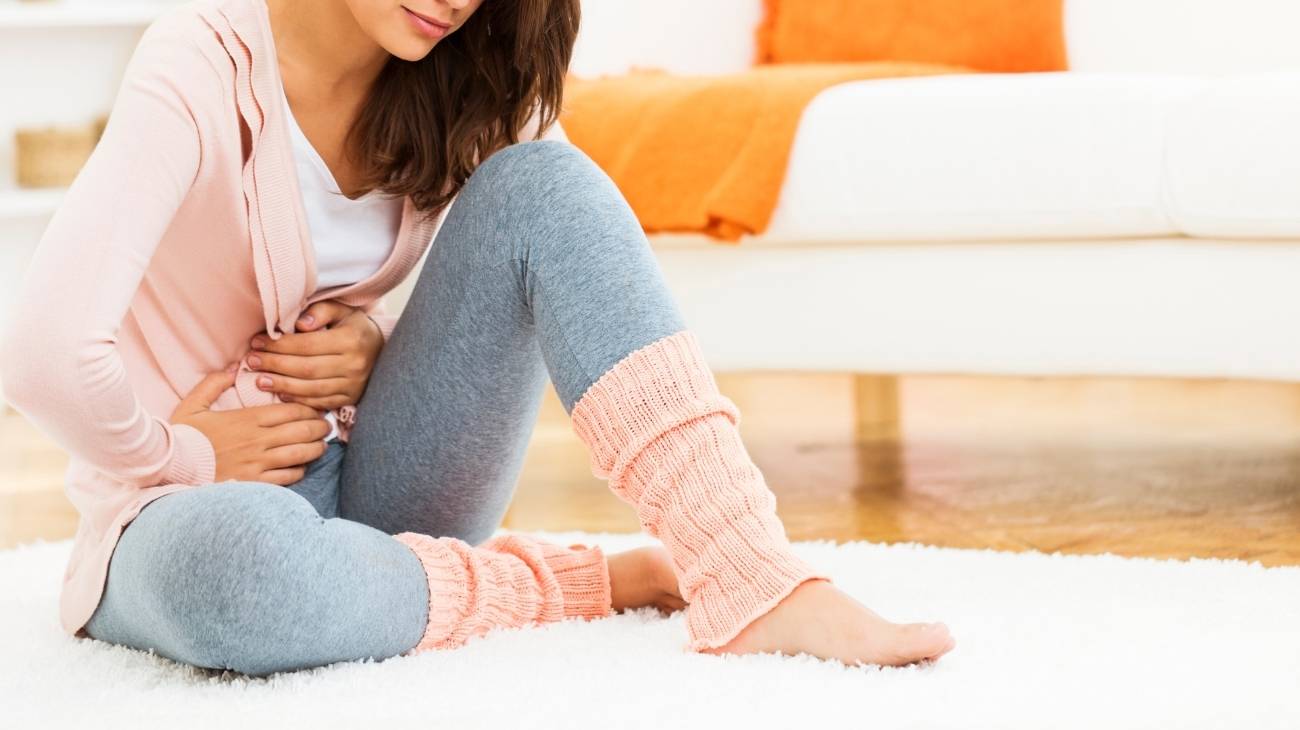- What are leg and calf muscle cramps?
- What causes involuntary muscle spasms in the legs and calves?
- Best products for leg cramps
- Main symptoms associated with muscle cramps in the legs
- How to relieve the pain and improve the symptoms of muscle cramps in the legs and calves?
- What are the most effective prevention methods for leg and calf muscle spasms?
Many people unexpectedly feel a muscle in their leg tighten and contract to the point of excruciating pain that lasts for several minutes. This is known as a muscle cramp or spasm and, although it can occur in different areas of the body, it usually affects the legs and calves.
Consequently, about 80% of muscle contractions occur in the lower extremities. Therefore, it is of great importance to know what these sudden cramps are, as well as their causes, associated symptoms, best treatments and precautionary techniques.
What are leg and calf muscle cramps?
In general terms, muscle cramps are defined as a contraction of the muscles that prevents them from relaxing and, at the same time, causes great temporary pain. Specifically, leg or calf cramps are those spasms that appear suddenly in the muscles connected to these limbs and appear as a kind of twinge.
Because of which, these contractures tend to reduce the ability to use the affected leg momentarily and often impact the calf muscle or the gastrocnemius muscle (the calf muscles), as well as the extensor, superficial and deep muscles. As such, they are characterised by significant muscle weakness and prevent the distension of the limbs due to the ailment or discomfort caused. However, cramps are not considered to be serious medical conditions.
What causes involuntary muscle spasms in the legs and calves?
By nature, everyone is likely to suffer from muscle spasms at some point in their lives, regardless of their age. However, although these spasms in the legs and calves do not have a single defined cause.
We list the main causes of involuntary cramps in the leg or calf muscles:
- Electrolyte disturbances, such as deficits of magnesium, potassium, calcium and sodium in the individual's body, are considered to be one of the main reasons for the occurrence of this type of spasm.
- Excessive fluid loss or low fluid levels in the body leading to dehydration also tend to produce muscle contractures in the lower limbs, especially in the legs.
- Accumulated tension in the calf muscles, either from inactivity, lack of stretching or chronic oedema in the lower legs, can cause this condition.
- Some brain disorders such as Parkinson's disease, Huntington's disease, multiple sclerosis and dystonia, due to their effects on the whole organism, cause the manifestation of intense cramps in the legs and calves of the patient.
- Other disorders or pathologies, such as: diabetes, renal insufficiency, anaemia or thyroid, are characterised by damage to the muscular system and therefore cause these spasms in the lower limbs.
- One of the ailments caused by Restless Legs Syndrome or RLS refers to muscle contractions in the legs. This condition stimulates the inevitable movement of these limbs and alters their function.
- Pregnant women may also experience constant muscle cramps in the leg or foot area. This is due to the swelling and slow blood return that is triggered by weight gain and hormonal changes.
- If the patient is taking certain drugs that disturb the body due to their side effects, they are likely to have contractures in their extensor, superficial and deep muscles.
- Another common cause of muscle spasm is nerve compression caused by a spinal cord injury or a pinched nerve in the back or neck.
Best products for leg cramps
Bestseller
-
2 Calf Compression Sleeve (Black/Gray)
£17,50 -
2 Calf Compression Sleeve (Green/Navy)
£17,50 -
2 Calf Compression Sleeve (Pink/Bordeaux)
£17,50 -
2 Knee Compression Sleeve (Black/Gray)
£17,50 -
2 Knee Compression Sleeve (Green/Navy)
£17,50 -
2 Knee Compression Sleeve (Pink/Bordeaux)
£17,50 -
2 Patella Knee Strap (Black/Gray)
£12,95 -
2 Patella Knee Strap (Green/Navy)
£12,95 -
2 Patella Knee Strap (Pink/Bordeaux)
£12,95 -
2 Thigh Compression Sleeve (Black/Gray)
£17,50 -
2 Thigh Compression Sleeve (Green/Navy)
£17,50 -
2 Thigh Compression Sleeve (Pink/Bordeaux)
£17,50 -
Acupressure Mat and Pillow (Black/Gray)
£44,95 -
Acupressure Mat and Pillow (Green/Navy)
£44,95 -
Acupressure Mat and Pillow (Pink/Bordeaux)
£44,95 -
Acupressure Pillow (Black/Gray)
£21,52 -
Acupressure Pillow (Green/Navy)
£21,52 -
Acupressure Pillow (Pink/Bordeaux)
£21,52 -
High Density Foam Roller for Muscle (Black/Gray)
£24,95 -
High Density Foam Roller for Muscle (Green/Navy)
£24,95 -
High Density Foam Roller for Muscle (Pink/Bordeaux)
£24,95 -
Ice Massage Roller Ball (Black)
£34,95 -
Ice Massage Roller Ball (Green)
£34,95 -
Ice Massage Roller Ball (Pink)
£34,95 -
Microwave Wheat Bag for Back Pain Relief (Extra Large) (Hearts)
£25,50 -
Microwave Wheat Bag for Back Pain Relief (Extra Large) (Oxford)
£25,50 -
Microwave Wheat Bag for Back Pain Relief (Extra Large) (Sport)
£25,50 -
Microwaveable Wheat Bag for Pain Relief (Hearts)
£17,50 -
Microwaveable Wheat Bag for Pain Relief (Oxford)
£17,50 -
Microwaveable Wheat Bag for Pain Relief (Sport)
£17,50 -
Pack 2 in 1: Foam Roller High + Soft Density (Black/Gray)
£24,95 -
Pack 2 in 1: Foam Roller High + Soft Density (Green/Navy)
£24,95 -
Pack 2 in 1: Foam Roller High + Soft Density (Pink/Bordeaux)
£24,95 -
Soft Density Foam Roller for Recovery (Black)
£24,95 -
Soft Density Foam Roller for Recovery (Green)
£24,95 -
Soft Density Foam Roller for Recovery (Pink)
£24,95 -
Sport Compression Socks (1 Pair) (Black/Gray)
£17,50 -
Sport Compression Socks (1 Pair) (Green/Navy)
£17,50 -
Sport Compression Socks (1 Pair) (Pink/Bordeaux)
£17,50 -
Trigger Point Massage Stick (Black)
£12,95 -
Trigger Point Massage Stick (Green)
£12,95 -
Trigger Point Massage Stick (Pink)
£12,95 -
Wheat Bag for Microwave Classic Bottle Shaped (Hearts)
£17,50 -
Wheat Bag for Microwave Classic Bottle Shaped (Oxford)
£17,50 -
Wheat Bag for Microwave Classic Bottle Shaped (Sport)
£17,50
Main symptoms associated with muscle cramps in the legs
To recognise a leg muscle cramp, it is important to consider the different signs and symptoms associated with this condition that disrupts the normal functioning of the legs.
Therefore, to avoid confusing a muscle spasm with other similar ailments, it is essential to know which signs describe the pathological state of contractures in the muscles located in the calves or legs, and for this reason, here we point out each one of them:
- Sudden, sharp pain in the leg muscles, especially the calf muscles.
- Swelling in the affected area that appears as a hard lump of muscle tissue under the skin.
- Tingling sensation and numbness (loss of sensation or flexibility) in the concussed leg or calf.
- Muscle weakness that tends to reduce the characteristic strength of the muscles attached to these parts of the body.
- Burning and warmth in the area that has been impacted by the spasm.
- Strong, spontaneous twitching or pulling in a particular muscle of the leg or calf
- Lack of energy and motivation to perform any activity (known as fatigue).
How to relieve the pain and improve the symptoms of muscle cramps in the legs and calves?
Fortunately, there are numerous therapies, treatments and indications that help to combat the symptoms that appear as a result of cramps and soothe the pain that these muscular contractions produce.
The following therapeutic techniques are ideal for minimising the discomfort of this involuntary condition:
Alternative and complementary therapies
Undoubtedly, one of the main solutions to relieve spasms in the muscles of the legs and elsewhere in the body are therapies. Since, by nature, they channel a healing response from the organism to eliminate the symptoms of contractures and even have the capacity to hinder their appearance.
Thus, some of the best alternative therapies for this are:
- Compression therapy: Using an elastic stocking and socks, compression therapy is a technique that exerts controlled pressure or force on an area of the human body to strengthen blood flow in order to normalise the function of the vascular wall and decrease venous pressure. Thus, it eliminates the ailment that appears when cramps occur. To apply this therapy, you should wear long orthopaedic compression stockings that strengthen the veins in the legs.
- Massage therapy: Therapeutically, massages performed on the legs or calves also help to relieve the pain caused by spasms. With the appropriate techniques, the specialist will rub and rub the affected limb to increase blood flow which helps to mitigate the discomfort. In addition, the massage will relax the area to reduce inflammation.
- Acupressure therapy: This treatment, designed by traditional Chinese medicine, is known for triggering a healing response from the patient to any ailment. By stimulating with the fingers and elbows certain strategic points on the human body that correspond to specific organs, emotions or feelings, acupressure therapy treats pain and attenuates muscle spasms in the legs, calves, feet and toes.
- Thermotherapy: This is one of the main procedures for treating injuries through the use of heat. By applying a higher temperature than that of the affected person's body, this therapy achieves a therapeutic, relaxing, sedative and anti-inflammatory effect, which reduces discomfort when contractures are present in the leg muscles. It should be noted that, in thermotherapy, experts can administer heat in solid, semi-liquid or gaseous form and the benefits will be the same.
- Natural remedies using plants: Another way to improve the symptoms of spasms and even combat them for life is to resort to natural remedies using specific plants that optimise blood circulation, alleviate ailments and deflate different areas of the body. In the case of leg or calf cramps, sufferers can use remedies such as: preparing meadowsweet dressings, applying boldo compresses, applying an arnica infusion and drinking infusions of dandelion, horse chestnut, rosemary or acai.
- Meditation and relaxation: To attack sudden cramps, it is also advisable to resort to meditation and relaxation with which the organism feels able to release any tension to obtain a complete state of peace which, as a result, allows the ailments present in the body to be minimised. Thus, a good way to treat the symptoms of spasms is based on practising yoga, tai chi, deep breathing, meditation, music therapy, etc.
- Aromatherapy: This is defined as an alternative treatment that, using aromatic liquids or essential oils from plants, flowers, herbs and bark, helps people to achieve great physical and psychological well-being. In such a way, it provides analgesic effects to eliminate pain, it also boosts defences, relaxes muscles, prevents cell ageing and counteracts anxiety. In aromatherapy, the best allies against cramp pain are: oregano, lavender, camphor, thyme, fennel, blue eucalyptus, laurel and cloves, for example.
- Acupuncture: This key component of traditional Chinese medicine is often used to treat pain and is therefore recommended to minimise the effects of spasms in the muscles of the human body. This is achieved by inserting fine needles into strategic locations to soothe ailments and improve blood circulation. In this case, you need to use a TCM practitioner to apply the appropriate pressure and massage the acupuncture points leading to relief for your leg or calf.
- Healthy lifestyle habits: If people affected by these strong contractures change their lifestyle and acquire more balanced habits, they will have a good chance of alleviating the discomfort that triggers cramps and may even be able to avoid them in the future, thanks to the optimal functioning of the organism. Some recommendations for this are: Drink plenty of fluids (especially water) to avoid dehydration, prevent stress and anxiety with yoga and meditation, do physical activities gradually without saturating the muscles and eat foods that provide vitamins and minerals.
Nutritional supplements
Another useful formula to treat sudden contractions in the legs and/or calves, consists of having a healthy diet that, at the same time, is combined with complementary foods characterised by containing good amounts of minerals, vitamins, fatty acids, amino acids and enzymes among its ingredients. This provides greater wellbeing to the organism and improves all its functions.
In this sense, to prevent the deficit of minerals that tend to produce muscle contractions in the limbs, you can consume the following food supplements that balance your daily diet to, in addition to mitigate the symptoms of spasms, also allow to prevent other more serious ailments:
- Magnesium: One of the main causes of cramps is the low level of magnesium in the body, as this electrolyte is responsible for regulating the functioning of the muscular and nervous system. Therefore, to alleviate this ailment, it is recommended to eat the following foods rich in magnesium: avocado, chickpeas, lentils, spinach, wholemeal bread, dark chocolate and nuts.
- Potassium: It is a mineral that helps to avoid the appearance of spasms in the muscles, due to the fact that it optimises the functioning of the muscles and the nervous system, as well as promoting water balance and improving a constant heart rhythm. In this sense, choose to eat foods that provide a good dose of potassium naturally; some of them are: banana or sweet potato, papaya, kiwi, broccoli, spinach, tomato, milk, yoghurt, fish and red meat.
- Sodium: This is a macromineral necessary for the nerves and muscles of the human body to function correctly in order to avoid conditions such as cramps, for example. Sodium helps the muscles to respond appropriately to any stimulus, generates nerve impulses and improves the concentrations of aqueous media. As a dietary supplement, it can be obtained from: milk and dairy products, fish and seafood, meat and meat products, sausages, fatty sausages, white bread, table salt and dehydrated broths.
- Calcium: is undoubtedly an essential mineral in the body because it interferes with the regulation of muscle contraction and also supports bone mineralisation. Thanks to this, calcium ensures a good functioning of the muscular system and even strengthens the nerves, thus helping to improve the symptoms of spasms quickly. So, to soothe or prevent such contractions in your legs or calves, you should consume calcium sources such as: milk, cheese, yoghurt, almonds, hazelnuts, orange, raspberry, broccoli, dried figs and Chinese cabbage.
- Omega 3: This is an essential oil in the human body, because it strengthens the blood vessels, improves the immune system, strengthens the heart and lungs, as well as having an anti-inflammatory effect. It therefore helps to reduce pain in the lower limbs caused by involuntary cramps. It should be noted that omega-3 can be ingested through: milk, yoghurt, eggs, fish, nuts, olive oil, soya, linseed and canola oil.
Medications
Sometimes, patients with this condition are unable to relieve their discomfort with alternative therapies or natural products. Despite the use of such solutions, the pain caused by the contraction remains intense and is even accompanied by a sensation of heat or burning, as well as inflammation and lasts longer than usual.
In such cases, it is best to see a specialised doctor who can deal with the eventuality in detail in order to provide a concise diagnosis. The doctor will then have the power to assign you a treatment assisted with the appropriate medication, depending on your medical history, your tolerance to the drugs, your state of health, your age and the severity of the pain in question.
Keeping in mind that self-medication can be downright dangerous, as it tends to lead to side effects such as dizziness, nausea, diarrhoea, fainting, drowsiness, cardiac arrest and even addiction.
What are the most effective prevention methods for leg and calf muscle spasms?
While it is true that just as it is possible to eliminate the pain caused by a muscle spasm in the legs or calves, it is also possible to follow a number of methods that help to prevent this condition for life. As a result, you will have a better lifestyle and your body will thank you for it.
Therefore, take into account the following effective practices to prevent this sudden ailment:
- Eat a healthy and balanced diet: If you eat foods rich in magnesium, potassium, calcium, sodium and omega 3, as well as plenty of fruit and vegetables, your body will be more vigorous to avoid contracting many diseases, including muscle cramps. The deficits that cause muscle cramps will be eliminated.
- Maintain an optimal level of hydration: It is also ideal to drink the recommended amount of water every day (2.7 litres for women and 3.7 litres for men) to prevent the body from feeling dehydrated and to avoid the loss of salts that, unfortunately, can lead to the appearance of spasms in the legs or calves and in any other area.
- Incorporate physical activity as a daily habit: If you exercise every day and gradually, you will help to keep your muscles in good condition and they will not contract to the point of causing strong contractures. It is important that, when you start a physical activity, you do not overload the muscles so that there are no further injuries.
- Stretch correctly: At a medical level, muscle stretching is considered to be an efficient therapy to reduce the frequency and severity of cramps in the lower limbs, especially at night. So don't forget to do stretching exercises regularly.
- Practice yoga or any relaxation technique: Both yoga and meditation reduce stress and anxiety levels in the human body, thus minimising tension in the muscles and tending to relax them. Thus, they are of great help in preventing leg spasms.
- Wear comfortable clothes and shoes: Another prevention method to avoid muscle spasms is to wear clothes that fit your legs and calves, as well as shoes that do not fit tightly. Otherwise, the muscles in your feet, calves and legs are likely to be strained by being cramped for too long, leading to painful contractions.
References
- Allen, R. E., & Kirby, K. A. (2012). Nocturnal leg cramps. American family physician, 86(4), 350-355. https://www.aafp.org/pubs/afp/issues/2012/0815/p350.html
- Butler, J. V., Mulkerrin, E. C., & O’keeffe, S. T. (2002). Nocturnal leg cramps in older people. Postgraduate medical journal, 78(924), 596-598. https://pmj.bmj.com/content/78/924/596.short
- Hensley, J. G. (2009). Leg cramps and restless legs syndrome during pregnancy. Journal of midwifery & women's health, 54(3), 211-218. https://www.sciencedirect.com/science/article/abs/pii/S1526952309000397
- Kim, D. H., Yoon, D. M., & Yoon, K. B. (2015). The effects of myofascial trigger point injections on nocturnal calf cramps. The Journal of the American Board of Family Medicine, 28(1), 21-27. https://www.jabfm.org/content/28/1/21.short
- Rana, A. Q., Khan, F., Mosabbir, A., & Ondo, W. (2014). Differentiating nocturnal leg cramps and restless legs syndrome. Expert review of neurotherapeutics, 14(7), 813-818. https://www.tandfonline.com/doi/abs/10.1586/14737175.2014.927734
- Miller, T. M., & Layzer, R. B. (2005). Muscle cramps. Muscle & Nerve: Official Journal of the American Association of Electrodiagnostic Medicine, 32(4), 431-442. https://onlinelibrary.wiley.com/doi/abs/10.1002/mus.20341
- Minetto, M. A., Holobar, A., Botter, A., & Farina, D. (2013). Origin and development of muscle cramps. Exercise and Sport Sciences Reviews, 41(1), 3-10. https://journals.lww.com/acsm-essr/fulltext/2013/01000/origin_and_Develop_of_muscle_cramps.3.aspx
- McGee, S. R. (1990). Muscle cramps. Archives of Internal Medicine, 150(3), 511-518. https://jamanetwork.com/journals/jamainternalmedicine/article-abstract/612935
- Bergeron, M. F. (2008). Muscle cramps during exercise-is it fatigue or electrolyte deficit?. Current Sports Medicine Reports, 7(4), S50-S55. https://journals.lww.com/acsm-csmr/fulltext/2008/07001/muscle_cramps_during_exercise_is_it_fatigue_or.9.aspx
- Miller, K. C., Stone, M. S., Huxel, K. C., & Edwards, J. E. (2010). Exercise-associated muscle cramps: causes, treatment, and prevention. Sports Health, 2(4), 279-283. https://journals.sagepub.com/doi/abs/10.1177/1941738109357299






































































